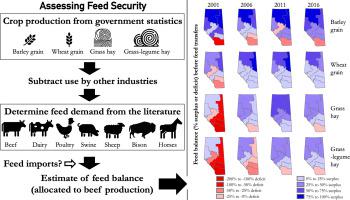Agricultural Systems ( IF 6.6 ) Pub Date : 2021-12-20 , DOI: 10.1016/j.agsy.2021.103348 M.R.C. Cordeiro 1, 2 , G.F. Mengistu 1, 2 , S.J. Pogue 3 , G. Legesse 1, 2 , K.E. Gunte 1, 2 , A.M. Taylor 1, 2 , K.H. Ominski 1, 2 , K.A. Beauchemin 3 , E.J. McGeough 1, 2 , M. Faramarzi 4 , T.A. McAllister 3

|
CONTEXT
Feed insecurity caused by increases in animal inventories and variability in feed production due to climate change is an emerging issue in livestock production. Regional feed transfers are one strategy used to address local feed shortages and minimize feed insecurity.
OBJECTIVE
This study assessed the importance of regional feed transfers for beef production in Alberta, Canada, by estimating regional feed production and demand based on livestock (beef, dairy, poultry, swine, sheep, bison, and horses) numbers and categories, enabling calculation of regional deficits and surpluses.
METHODS
Transfers from crop-producing regions in Alberta were estimated to address potential feed shortages for beef production in 2001, 2006, 2011 and 2016. The analysis included feeds that could be cost-effectively transported, namely, barley grain, wheat grain, grass hay, and grass-legume hay. Feed demands of beef and other livestock were estimated at the county level and aggregated to seven land-use framework (LUF) regions. Feed balances available for beef production were estimated for the four feeds based on crop yields in each year. Feed transfers from surplus to deficit LUF regions were hierarchically estimated based on transport distance. Feed inputs from outside the province were not considered in the analysis due to the lack of data on cross-boundary imports.
RESULTS AND CONCLUSIONS
The average feed demand for beef production between 2001 and 2016 in Alberta was 2.71, 0.68, 2.21, and 1.95 M tonnes of dry matter (DM) for barley grain, wheat grain, grass hay, and grass-legume hay, respectively. The results indicated that the South Saskatchewan region of Alberta had the greatest feed deficit and required transfers from other regions in all years. Feed balances were consistently negative in this region between 2001 and 2016, with barley grain ranging from −97.2% to −34.2% (deficit), wheat grain from −31.4% (deficit) to 19.3% (surplus), grass hay from −147.2% (deficit) to 1.6% (surplus), and native grass-legume hay from −167.7% to −15.7% (deficit). Unmet demand of barley grain (2006), grass hay (2001) and grass-legume hay (2001, 2006) at the provincial level were likely met by importing these feedstuffs from outside of the province.
SIGNIFICANCE
The methodology presented here can be adapted to other intensive livestock producing regions to assess feed security issues associated with climate change and devise effective feed transfer strategies and provide information that can be used for future consideration of the regional impact of these practices on greenhouse gas emissions, biodiversity, as well as other environmental indices.
中文翻译:

评估牲畜密集地区牛肉生产的饲料安全
语境
由动物库存增加和气候变化引起的饲料生产变化导致的饲料不安全是畜牧生产中一个新出现的问题。区域饲料转移是用于解决当地饲料短缺和最大限度减少饲料不安全的一种策略。
客观的
本研究通过根据牲畜(牛肉、奶制品、家禽、猪、羊、野牛和马)的数量和类别估算区域饲料生产和需求,评估了区域饲料转移对加拿大艾伯塔省牛肉生产的重要性,从而能够计算区域赤字和盈余。
方法
据估计,从艾伯塔省农作物产区的转移可以解决 2001 年、2006 年、2011 年和 2016 年牛肉生产的潜在饲料短缺问题。和草豆类干草。牛肉和其他牲畜的饲料需求在县级进行估计,并汇总到七个土地利用框架 (LUF) 区域。四种饲料的可用于牛肉生产的饲料平衡是根据每年的作物产量估算的。根据运输距离分层估计从过剩到短缺 LUF 区域的饲料转移。由于缺乏跨境进口数据,分析中没有考虑来自省外的饲料投入。
结果和结论
2001 年至 2016 年艾伯塔省牛肉生产的平均饲料需求分别为 2.71、0.68、2.21 和 195 万吨干物质 (DM),用于大麦粒、小麦粒、草干草和豆科干草。结果表明,阿尔伯塔省的南萨斯喀彻温地区的饲料缺口最大,需要从其他地区转移。2001 年至 2016 年期间,该地区的饲料平衡一直为负,大麦谷物从 -97.2% 到 -34.2%(赤字),小麦谷物从 -31.4%(赤字)到 19.3%(盈余),干草从 -147.2 %(赤字)到 1.6%(盈余),原生草豆科干草从 -167.7% 到 -15.7%(赤字)。大麦谷物 (2006)、草干草 (2001) 和草豆科干草 (2001,
意义
此处介绍的方法可适用于其他集约化畜牧生产区,以评估与气候变化相关的饲料安全问题,制定有效的饲料转移战略,并提供可用于未来考虑这些做法对温室气体排放的区域影响的信息,生物多样性以及其他环境指标。


























 京公网安备 11010802027423号
京公网安备 11010802027423号